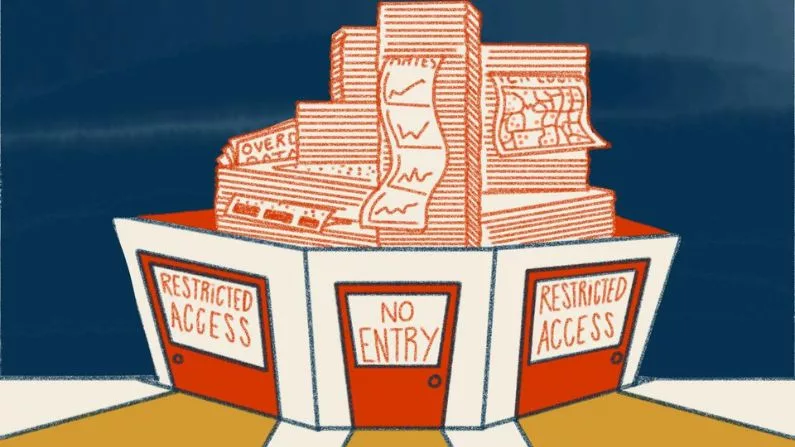By Madelyn Beck, WyoFile.com
Levi Wardell knows more about drug use and overdoses than anyone should.
He started using meth at 15 with his dad in Cheyenne. Alcohol abuse and other drugs followed in meth’s wake. He entered recovery four years ago after surviving several overdoses and other devastating consequences of his addiction.
Addiction’s deadly costs are still a part of his day-to-day life, but now from a new perspective. As a funeral director and practitioner apprentice at the Wiederspahn-Radomsky Chapel of the Chimes in the capital city, Wardell helps families who have lost one of their own to an overdose. Some saw it coming. Many didn’t.
“It is not just the typical ‘junkies’ and ‘druggies,’” he said. “We get a lot of really good families that come through here that are planning the funeral … and they’re just brokenhearted.”

Levi Wardell has gone from using drugs in the past to helping others who’ve lost loved ones to overdoses as a funeral director in Cheyenne. (Jasmine Hall/WyoFile)
In mid-April, three likely overdose deaths came through the funeral home’s door in a single week — the most Wardell can remember seeing in such a short timeframe. Of course, he only knows they’re overdoses when families tell him, so he may have missed other surges. The rising body count corresponds to the state’s influx in illicit fentanyl — an extremely potent and cheap man-made opioid.
For Wardell, it seems the overdose deaths keep coming.
“I feel like we’re getting them once a week,” he said. “And maybe that’s exaggerated, it just seems like they’re constant.”
Tattoos peaked from the cuffs of Wardell’s blue tailored suit as he related his experience in the basement of a beautiful suburban home across from a park. His pregnant wife and young daughter went about their lives upstairs.
For his little girl’s sake, he hopes the scourge of overdoses and deadly synthetic opioids like fentanyl gets more attention around Wyoming. Fentanyl and its analogs have been a growing danger around the state and the nation.
“That should be getting just as [many] headlines as freaking COVID,” he said of the opioid epidemic. “People are dropping left and right, and it’s not just junkies and criminals.”
Fentanyl is increasingly being mixed into drugs like meth or cocaine, but it’s also pressed into pills that can look deceptively similar to pharmaceuticals like Oxycontin and Adderall. The varying strength of these drugs can blindside users — from those with long-term substance use disorders to teens experimenting at a party — with deadly consequences. These powerful opioids are even making their way into schools.
Laramie County School District 1 started stocking Narcan in every school and outlying building on Jan. 15, according to school nurse Janet Farmer. They’ve already used the opioid reversal drug once, Farmer said in early May. They would have used it once or twice more if they’d had access to the life-saving drug sooner.
“People are dropping left and right, and it’s not just junkies and criminals.” – LEVI WARDELL
The school district isn’t the only institution or organization taking proactive steps to combat the opioid epidemic — often in response to hard-earned direct experience — but such efforts remain rare and disconnected. That’s partially because comprehensive statewide awareness and nuanced community-based interventions have been hampered by limited access to timely information about what’s happening in their own communities.
WyoFile found through six months of reporting that access to Wyoming’s overdose data is so limited it’s often unusable. By the time many of the people working to save lives learn about an influx of tainted drugs, or a spike in overdoses, it’s already too late — even though the data often exists.
Health officials and local experts say the cautious approach to data dissemination is due to privacy and accuracy concerns that arise, in part, from the state’s small population and correspondingly small numbers of overdoses. Other rural states like Alaska and Missouri, meanwhile, have figured out how to provide far more data in a timely manner.
But in Wyoming, information that is potentially life-saving is not reaching the people who could warn residents about specific, real-time local risks, provide overdose reversal drugs or prepare and equip first responders.
In this four-part series, WyoFile examines the data Wyoming officials collect, the information that is shared with the public and what the disparity between those two means for those working across the state to stem the tide of overdoses and death.
Suspected overdoses
Data obtained by WyoFile through records requests shows that in January of this year, Wyoming EMS workers responded to a significant spike in suspected overdoses.
Laramie County EMS recorded the most with 32— the highest monthly number in the five years of data WyoFile procured. The tally includes suspected overdoses and does not specify whether or not the patient died. It excludes overdoses in which a person was contacted and revived by someone other than EMS personnel.
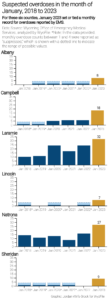 Several other counties saw record overdose numbers in January, too, according to the EMS data, including Natrona (27), Campbell (18), Sheridan (9) and Lincoln (7). Some counties tied with previous records in January, like Albany (8). County population rates revealed this trend, too. However, this analysis can’t show whether there are similar trends in other counties because the Wyoming Department of Health shielded small numbers over privacy concerns.
Several other counties saw record overdose numbers in January, too, according to the EMS data, including Natrona (27), Campbell (18), Sheridan (9) and Lincoln (7). Some counties tied with previous records in January, like Albany (8). County population rates revealed this trend, too. However, this analysis can’t show whether there are similar trends in other counties because the Wyoming Department of Health shielded small numbers over privacy concerns.
But the spike in EMS-suspected overdoses is something Laramie County Commissioner Gunnar Malm says he wasn’t privy to.
“It just goes back to one of the biggest problems probably in government efficiency in general, is the siloization of information,” he said. “When you have these silos and different agencies responsible for different things, it’s really hard to make sure that you have good collaboration.”
An influx of locally controlled resources, and the corresponding opportunity for on-the-ground officials to effect meaningful change, make the knowledge gap between EMS and policy makers all the more consequential.
Laramie County, like many other counties and towns, has a big new pot of money to combat the opioid crisis. The funds came from legal settlements stemming from over prescription of opioid pain medications that caused many to develop addictions.
As of late last year, the Wyoming Attorney General’s office calculated the state would receive about $9.4 million from the first few settlements — and more is expected from other settlements in the works. Counties and local communities will get 65% of the total settlement, according to the OneWyo Opioid Settlement Memorandum of Agreement.
Laramie County alone is expecting more than $1 million in settlement funds, according to Malm. The county is collaborating more with medical professionals, the coroner and law enforcement to figure out how best to spend the money, he said. Because of his experience, addiction treatment resources are also a personal priority.
“I’m actually a person in long-term recovery myself,” he said. “I’m an alcoholic. So I have about seven and a half years sober at this point.”
“It just goes back to one of the biggest problems probably in government efficiency in general, is the siloization of information.” – LARAMIE COUNTY COMMISSIONER GUNNAR MALM
Even with input from a broad array of stakeholders, though, leaders say better data could help them make better decisions. In Campbell County, Commissioner Colleen Faber says they’re working to allocate settlement funds, too.
“We didn’t have any hard data or numbers to say, ‘OK, our opioid use is really high or fentanyl is increasing by this much in the county,’ which would be helpful, in my opinion,” she said.
Campbell County received about $300,000 in its first settlement payment, County Administrative Director Denton Knapp said, and commissioners are working with local groups and experts to figure out how to spend it. When asked, neither Knapp nor Faber said they were aware of a spike in overdoses.
Asked about the January overdose spike, Wyoming Department of Health Director Stefan Johansson asked WyoFile to share the analysis that demonstrated the trend. WDH spokesperson Kim Deti then followed up that WyoFile should be cautious with the data to avoid misrepresenting the severity of the problem.

Stefan Johansson directs the Wyoming Department of Health, which oversees the Office of EMS. He says WDH provides all the overdose information it can. (Wyoming Department of Health)
The analysis in this series followed strict protocols to focus on statistically significant and certain trends. The raw data provided by WDH pre-analysis is here.
It’s unclear whether Johansson was previously aware of the spike, but he maintains that “siloed” communication is not a challenge for the WDH.
“We don’t have any issues sharing data within the department,” Johansson said. “And so maybe there’s a perception that behavioral health division is operating in its vacuum and EMS or public health is operating in its vacuum. [But that’s] certainly not the case.”
Hidden in plain sight
Aaron Koehler noticed the January uptick in overdoses while compiling information WyoFile requested, he said. He directs the Office of EMS, which is responsible for providing statewide overdose information to the federal NEMSIS database. That data set shows approximate rates of nonfatal opioid overdoses by state and county. It was released to the general public late last year.
As of June 1, NEMSIS showed that Wyoming had lower-than-average nonfatal overdoses as reported by EMS. At the county-level, though, Fremont was higher than the national average, while Sweetwater and Laramie were around the average. This changes frequently, though.
The Wyoming OEMS is a small team with a big job that goes well beyond data collection and dissemination, Koehler said.
“I’m here to regulate the EMS profession and provide the best patient care,” he said. While other WDH offices are tasked with focusing on data work, “we have a very small, very small office of one data manager, who does his best.”
In 2020, the state cut the OEMS budget by nearly 30%. Still, getting more information to the public is the right thing to do, Koehler said, and he intends to make it happen.
“I really do feel that we’re public servants. We’re here to serve the public,” he said. “With a lot of things going on in the country right now, providing data, providing hard evidence, and really being able to show the full, fully encompassed story of what’s going on, I think it’s very important.”
As for spreading the word about the spike, Koehler said he’d want data from more recent months before declaring that this is an actual trend, but assured WyoFile there are ongoing discussions about how to better communicate this kind of information to the public and other stakeholders.
“With a lot of things going on in the country right now, providing data, providing hard evidence, and really being able to show the full, fully encompassed story of what’s going on, I think it’s very important.” – OEMS DIRECTOR AARON KOEHLER
One of the biggest puzzles is how to share information without revealing exactly who overdosed — a real challenge in Wyoming’s small towns. In the OEMS data obtained by WyoFile, officials “suppressed” — or omitted — every data point in which there were between one and four suspected overdoses in a county in a given month to secure individuals’ privacy. That’s standard practice in other states and federal agencies. The privacy measure comes at a cost though: It can leave sparsely populated rural areas in the dark and make trends hard to spot.
In addition to privacy, analysts have concerns about statistical relevance in smaller communities. No one, for example, wants to rewrite policy because overdoses “increased by 100%” if the actual change is from one person to two.
“It’s one thing to be in New York City and count the number of opioid overdoses; it’s another thing to be in Pinedale, right?” said Rodney Wambeam, a senior research scientist with the Wyoming Survey & Analysis Center. “It doesn’t mean Pinedale might not have a bigger problem per capita, it’s just that when numbers are so small, it’s hard to know.”

Rodney Wambeam is a senior research scientist with the Wyoming Survey & Analysis Center. He’s worked all around the U.S., but his organization recently secured a grant from the Wyoming Department of Health to get a better grasp on the state’s opioid-related data needs. (Megan Lee Johnson/WyoFile)
There could be steady overdose increases in Albany, Teton or Sheridan Counties, for example, but because of how much EMS data was suppressed to protect privacy, it’s impossible to say.
Even with these limitations, a WyoFile analysis found — with a high level of mathematical certainty — that several Wyoming counties have seen a steady increase in EMS-reported overdoses over the past several years.
Identifying and conveying local trends is still important, Wambeam said, because even though Wyoming communities share similarities, they each handle problems in their own way.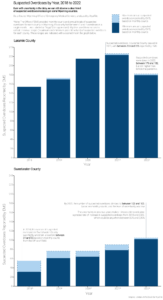
Wambeam and WYSAC will be working over the next year and a half to get a better grasp on the state’s opioid-related data needs, as contracted by WDH’s Behavioral Health Division.
“Through federal funding from the Substance Abuse and Mental Health Services Administration (SAMHSA), the Agency has the opportunity to address the opioid misuse epidemic through data collection and aligning goals, strategies, and activities,” WDH’s request for proposal states. “The goal of this needs assessment and strategic planning process is to create a deeper understanding of the data and a roadmap for addressing this complex epidemic.”
This is a step in the right direction, but it could mean years of waiting on more local data to inform the types of interventions that could save lives.
Meantime, volunteers are on the ground working with, and advocating for, people who use drugs in the state.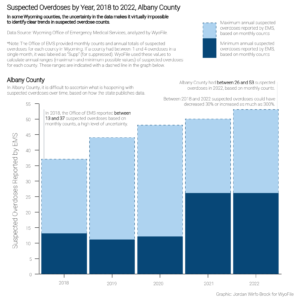
Ariel Bernath works with the Wyoming Harm Reduction Collective, and said the group is doing its best with limited data and resources. More local, timely information could help them save lives, she said.
Having information like the EMS data that WyoFile procured makes it “so much easier to make a case for more grant money in the state,” she said.
That grant money could be used for outreach and to bring more harm-reduction tools like fentanyl test strips and naloxone into the areas that need them most and in a manner that responds directly to fact-based need.
“But also, maybe down the line, [it could inform] policy changes too,” she said. “Lawmakers are often interested in data.”

Ariel Bernath volunteers with the Wyoming Harm Reduction Collective. She believes timely local data could help bring more targeted grant money into areas that need it most. (Megan Lee Johnson/WyoFile)
Counting the dead
EMS data could include both fatal and nonfatal overdoses, but doesn’t differentiate between the two. The state relies on its 23 county coroners to tally drug overdose deaths.
WDH’s statewide dataset shows these deaths have remained fairly level over the last decade — but once again, local trends are harder to spot with limited data.
Ninety-six Wyoming residents died from drug overdoses in 2013. Annual totals dipped as low as 60 in the intervening years, before climbing again. Ninety-three people died from drug overdoses last year.
The state provides five-year averages for overdose deaths by county — a metric that may not paint the clearest picture during a time of rapid change. Wyoming experienced a decrease in overdose deaths about five years ago, for example, followed by a more recent increase. That fluctuation could inform response efforts. But a five-year average of the same data can obscure changes over time and instead could show little or no change.
Deti with WDH acknowledges that balancing medical privacy concerns with the limited data can lead to unsatisfactory results.
“There is no comprehensive or definitive source of data that can tell you how many overdoses occurred in the state or by county,” she stated in an email. “The pieces of that puzzle that are available are not complete. Again, that may be frustrating but it is also true.”
Director Johansson echoed those points, adding that WDH also aims to provide the most accurate data, which can take time and limit what’s released.
“We provide what we can, and that has some constraints, both in terms of data availability and [data privacy],” he said.
The result is WDH information with limited utility for local leaders.
The Centers for Disease Control and Prevention publishes county-level overdose data in Wyoming that suppresses data sets with fewer than 10 deaths for each month. But that, too, leaves many counties’ data completely in the dark.
County coroners can also supply information, and a few gave WyoFile information for 2022: Natrona County had 17 overdose deaths, Sweetwater County had 13 and Fremont County had 16.
Coroners often provide that data to local leaders too, though single-county information doesn’t reveal what’s going on in neighboring areas.
WDH does publish a Wyoming opioid dashboard with additional information, like ages of the deceased. Much of the dashboard’s data was between three and four years old before being updated in early May following repeated WyoFile requests for data. The resource now includes overdose death rates through 2022 — but still relies on five-year averages for counties.
The dashboard’s emergency room visits and hospitalization rates are still only updated through 2019.
Other states like Alaska and Missouri have dashboards that share annual rates of fatal overdoses and hospitalization numbers, even for rural areas. According to people working with both states’ health departments, they haven’t heard privacy concerns over the dashboard data they provide.
Alaska launched its dashboard in 2017 after the governor issued a disaster declaration because of the opioid epidemic, according to Jessica Filley with the Alaska Department of Health and Social Services. The state recorded 100 opioid overdose deaths that year.
Since then, Filley said, stakeholders have met every few weeks to update the dashboard and get data to groups requesting it — including legislators, reporters and grant writers. It currently has overdose death data through August 2022 and reveals local data at the health district level.
“The people I hear back from … it gives them awareness of the general issues,” she said of the dashboard.
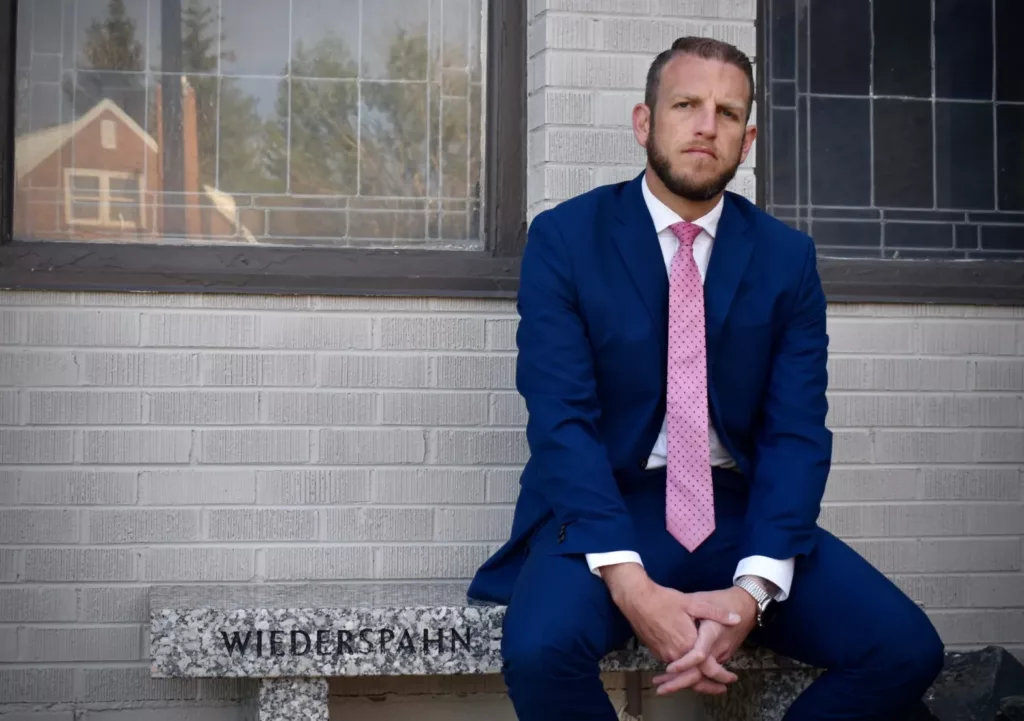
Levi Wardell wants the opioid pandemic to be treated more like COVID-19 with more local data getting into the hands of the public. (Jasmine Hall/WyoFile)
In 2019, when much of Wyoming’s drug overdose-involved emergency room and hospitalization data was last updated, Levi Wardell was still using illicit drugs. Around that period, he said, he first encountered a drug driving increases in overdose deaths around the county and the region.
“I remember towards the end of my using, I bought some fentanyl pills,” he said. “The dealer was like: ‘yeah, this is fentanyl pills. Be careful.’”
They looked like oxycontin, he said, but his dealer told him they weren’t. He bought heroin that he knew was laced with fentanyl, too, he said. Nowadays, though, he said people are buying what they think is oxycontin or other drugs. Instead, it’s fentanyl.
And people are dying because of it.
In part two, WyoFile focuses on fentanyl trends in Wyoming and what they portend for the state’s future.
If you or someone you know is having suicidal thoughts, you can call or text the Suicide Prevention Lifeline at 988.
This investigation was supported with funding from the Data-Driven Reporting Project. The Data-Driven Reporting Project is funded by the Google News Initiative in partnership with Northwestern University | Medill.
Data analysis and visualizations are by Jordan Wirfs-Brock, who you can follow on Mastodon @jordanwb@hci.social.
WyoFile is an independent nonprofit news organization focused on Wyoming people, places and policy.

